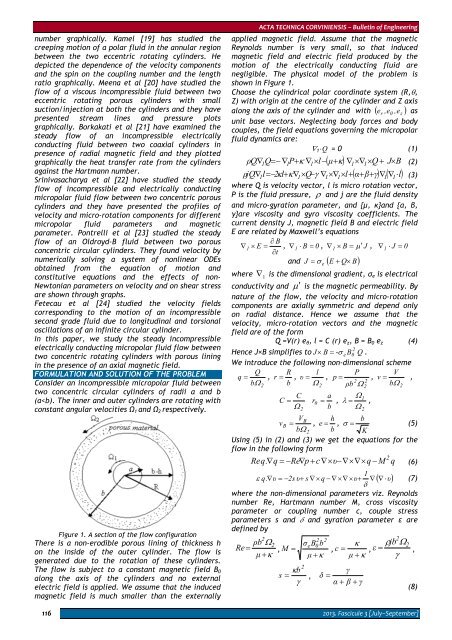steady mhd flow of micropolar fluid between two rotating cylinders ...
steady mhd flow of micropolar fluid between two rotating cylinders ...
steady mhd flow of micropolar fluid between two rotating cylinders ...
You also want an ePaper? Increase the reach of your titles
YUMPU automatically turns print PDFs into web optimized ePapers that Google loves.
number graphically. Kamel [19] has studied thecreeping motion <strong>of</strong> a polar <strong>fluid</strong> in the annular region<strong>between</strong> the <strong>two</strong> eccentric <strong>rotating</strong> <strong>cylinders</strong>. Hedepicted the dependence <strong>of</strong> the velocity componentsand the spin on the coupling number and the lengthratio graphically. Meena et al [20] have studied the<strong>flow</strong> <strong>of</strong> a viscous incompressible <strong>fluid</strong> <strong>between</strong> <strong>two</strong>eccentric <strong>rotating</strong> porous <strong>cylinders</strong> with smallsuction/injection at both the <strong>cylinders</strong> and they havepresented stream lines and pressure plotsgraphically. Borkakati et al [21] have examined the<strong>steady</strong> <strong>flow</strong> <strong>of</strong> an incompressible electricallyconducting <strong>fluid</strong> <strong>between</strong> <strong>two</strong> coaxial <strong>cylinders</strong> inpresence <strong>of</strong> radial magnetic field and they plottedgraphically the heat transfer rate from the <strong>cylinders</strong>against the Hartmann number.Srinivasacharya et al [22] have studied the <strong>steady</strong><strong>flow</strong> <strong>of</strong> incompressible and electrically conducting<strong>micropolar</strong> <strong>fluid</strong> <strong>flow</strong> <strong>between</strong> <strong>two</strong> concentric porous<strong>cylinders</strong> and they have presented the pr<strong>of</strong>iles <strong>of</strong>velocity and micro-rotation components for different<strong>micropolar</strong> <strong>fluid</strong> parameters and magneticparameter. Pontrelli et al [23] studied the <strong>steady</strong><strong>flow</strong> <strong>of</strong> an Oldroyd-B <strong>fluid</strong> <strong>between</strong> <strong>two</strong> porousconcentric circular <strong>cylinders</strong>. They found velocity bynumerically solving a system <strong>of</strong> nonlinear ODEsobtained from the equation <strong>of</strong> motion andconstitutive equations and the effects <strong>of</strong> non-Newtonian parameters on velocity and on shear stressare shown through graphs.Fetecau et al [24] studied the velocity fieldscorresponding to the motion <strong>of</strong> an incompressiblesecond grade <strong>fluid</strong> due to longitudinal and torsionaloscillations <strong>of</strong> an infinite circular cylinder.In this paper, we study the <strong>steady</strong> incompressibleelectrically conducting <strong>micropolar</strong> <strong>fluid</strong> <strong>flow</strong> <strong>between</strong><strong>two</strong> concentric <strong>rotating</strong> <strong>cylinders</strong> with porous liningin the presence <strong>of</strong> an axial magnetic field.FORMULATION AND SOLUTION OF THE PROBLEMConsider an incompressible <strong>micropolar</strong> <strong>fluid</strong> <strong>between</strong><strong>two</strong> concentric circular <strong>cylinders</strong> <strong>of</strong> radii a and b(a
















